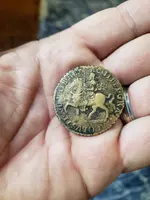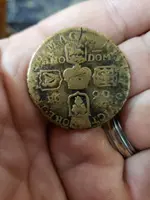You're welcome. I expect you've Googled for what these coins were all about, but there's an interesting socio-political history as the backstory.
When Charles II died in 1685 (having converted to Catholicism on his deathbed) the thrones of England, Scotland and Ireland passed to his elder brpther James as James II of England and Ireland (and James VII of Scotland). Although there was widespread support for his eligibility by birth, he had also converted to Catholicism in 1668 or 1669 during his time in France and kept it secret for 10 years. English tolerance for his personal Catholicism did not extend to tolerance of Catholicism in general and a largely Protestant/Anglican Parliament gave him a hard time as he began to throw his weight around. So too did the clergy, and the general public also began to turn against him. When he began to protect his power in a heavy-handed manner by enlarging his army in ways that were technically illegal except in time of war, his popularity dropped futher.
Events took a turn for the worse in 1688 with the birth of son, raising the prospect of initiating a Roman Catholic dynasty which would exclude his Anglican daughter Mary and her Protestant husband William of Orange (a sovereign Prince in the Netherlands). The consensus was that James had to go to if Civil War was to be averted, and the solution would be for William to assume power in England. It was known that he had aspirations to take the throne but was reluctant to take such a bold step without knowing he would be welcome. As part of the scheming, he insisted on being sent a letter of invitation to invade, which the leading members of the political class in England sent in secret. The letter guaranteed that he would receive material support, accompanied by a general rising up of the populace against James. William then obliged, landing with a large army on the south coast of England in November 1688.
James’ army deserted him without putting up much of a fight, William allowed him to escape to France a month later to avoid him becoming a martyr to Catholicism, and he went into exile under the protection of Louis XIV. There was a bit of a stand-off with Parliament over whether William could reign as King in his own right rather than as consort to his wife who technically preceded him in the line of succession to the throne. There was also argument about whether the monarchy was absolute as a God-given right passed on by lineage or something to be delegated by Parliament. After extensive pollical skirmishing William and Mary were jointly crowned in April 1689.
There was still a significant minority who remained loyal to the deposed King James who hoped to get him reinstated and the highest level of dissent against William was in the predominantly Catholic Ireland. The Irish Parliament declared that James remained King and (instigated by James) passed legislation that effectively designated those who had rebelled against him as traitors who had committed acts of treason. James then landed in Ireland in March 1689 with a small contingent of French troops and began to build an army of supporters in Ireland with the ultimate aim of reclaiming the throne.
It was that army which was paid by what became known as ‘gun money’, from the popular belief that the brass was obtained by melting down old cannon barrels. Some of it was, but he used everything he could get his hands on from church bells to kitchen pans. Silver coinage was in desperately short supply in Ireland and even copper/brass were scarce commodities. The understanding was that the brass token coins would be redeemed for silver after James’ army had prevailed. The rationale for putting the month of issue on the coins, as well as the year, was that interest would be paid when they were finally redeemed.
In response to James' arrival in Ireland, William raised a huge invasion force to put down any kind of rebellion and James’ raw recruits were defeated at the Battle of the Boyne on 1st July 1690, after which James fled back to France, never to return. Limited fighting continued in his absence until the Treaty of Limerick in October 1691 after which some 11,000 Irish soldiers also fled to France.
William’s supporters (“Orangemen”) later adopted a gleeful mocking toast that runs:
“Here’s to the pious, glorious and immortal memory of the great and good King William III, Prince of Orange, who saved us from rogues and roguery, slaves and slavery, knaves and knavery, popes and popery, brass money and wooden shoes and whoever denies this toast may he be slammed, crammed and jammed into the muzzle of the great gun of Athlone, and the gun fired into the Pope’s belly, and the Pope into the devil’s belly, and the devil into hell, and the door locked, and the key in an Orangeman’s pocket, and may we never lack a brisk Protestant boy to kick the arse of a papist and here’s a fart for the Bishop of Cork”.
William died of pneumonia in 1702 as one of a number of complications arising from a fractured collar bone sustained when his horse stumbled on a molehill while he was out riding. Remaining supporters of James (“Jacobites”) adopted a rather less colourful toast with an oblique reference to the mole as:
“Here’s to the little gentleman in the black velvet waistcoat who did such service in 1702”.





